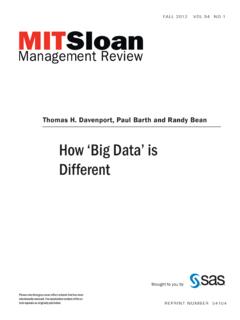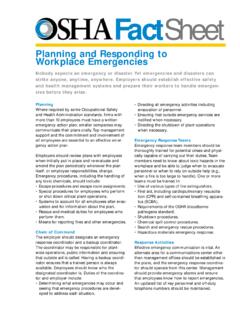Transcription of Greenhouse Gas Inventory Guidance: Direct Emissions from ...
1 Greenhouse Gas Inventory Guidance Direct Emissions from Mobile Combustion Source December 2020 The EPA Center for Corporate Climate Leadership s (The Center) GHG guidance is based on The Greenhouse Gas Protocol: A Corporate Accounting and Reporting Standard (GHG Protocol) developed by the World Resources Institute (WRI) and the World Business Council for Sust ainable Development (WBCSD). The Center s GHG guidance is meant to extend upon the GHG Protocol to align more closely with EPA-specific GHG calculation methodologies and emission fa ctors, and to support the Center s GHG management tools.
2 For more information regarding the Center for Corporate Climate Leadership, visit Table of Contents Table of Contents Introduction .. 1 Scope 1 versus Scope 3 Mobile Source Emissions .. 2 Greenhouse Gases Included .. 2 3 Calculating CO2 Emissions .. 4 Calculating CH4 and N2O Emissions .. 6 Choice of Activity Dat a and Emission Factors .. 7 Activity Data .. 7 Fuel Carbon Content and Heat Content .. 9 Emission Factors .. 10 Complet eness .. 11 Uncertainty Assessment .. 12 Documentation .. 13 Inventory Quality Assurance and Quality Control (QA/QC) .. 14 Appendix A: Default CO2 Emission Factors.
3 15 Appendix B: Default CH4 and N2O Emission Factors .. 17 Direct Emissions from Mobile Sources Section 1: Introduction EPA Center for Corporat e Climate Leadership GHG Inventory Guidance 1 Introduction Greenhouse gas (GHG) Emissions are produced by mobile sources as fuels are burned. Carbon dioxide (CO2), methane (CH4), and nitrous oxide (N2O) are emitted directly through the combustion of fuels in different types of mobile equipment. A list of mobile sources that could potentially be included in an organization s GHG Inventory is provided in Table 1. GHG Emissions from mobile sources also include hydrofluorocarbon (HFC) and perfluorocarbon (PFC) Emissions from mobile air conditioning and transport re frigera tion leaks.
4 The calculation of fugitive HFC and PFC Emissions from mobile sources is described in the Center s guidance for Direct Fugitive Emissions from Refrigera tion, Air Conditioning, Fire Suppression, and Industrial Gases. Table 1: Cat egories of Mobile Sources Category Primary Fuels Used Onroad V ehicles Passenger Cars Gasoline Vans, Pickup Trucks & SUVs Diesel Fuel Heavy-Duty Vehicles Combination Trucks Buses Nonroad Vehicles Construction Equipment Diesel Fuel Agricultural Equipment Forklifts Other Nonroad Equipment Waterborne Ships Diesel Fuel Boats Residual Fuel Oil Gasoline Rail Freight Tr ains Diesel Fuel Commuter Rail Electric Amtrak Air Commercial Aircraft Kerosene Jet Fuel Executive Jets Direct Emissions from Mobile Sources Section 1.
5 Introduction EPA Center for Corporat e Climate Leadership GHG Inventory Guidance 2 Scope 1 versus Scope 3 Mobile Source Emissions This document presents the guidance for calculating scope 1 Direct GHG Emissions resulting from the opera tion of owned or leased mobile sources that are within an org anization s i nventory boundary. This guidance applies to all sectors whose operations include owned or leased mobile sources. All other org anization-r elated mobile source Emissions , including employee commuting, employee travel, and upstream/ downstream third-party transportation Emissions , such as those associat ed with transporting material inputs or product distribution, are considered scope 3 indirect Emissions .
6 This guidance document focuses on scope 1 Emissions . While some of the approaches in this document can also apply to scope 3 sources, org aniza tions should refer to the separate scope 3 guidance document for specific approaches to calculate scope 3 mobile source Emissions . Furthermore, this guidance focuses on accounting for Emissions resulting directly from an org anization s activities, not on the full life cycle Greenhouse gas Emissions associated with those activities. For example, a fleet owner would use this guidance to account for Emissions resulting from fleet fuel usage, but not for the Emissions associated with producing the fuel.
7 Users of this guidance should be aware, however, that the choice of transportation modes and fuels can greatly influence GHG Emissions from a life cycle perspective. A transportation mode may hav e relati vely few GHG Emissions from the vehicle itself, but Emissions could be higher from the production of the fuel. Greenhouse Gases Included The Greenhouse gases CO2, CH4, and N2O are emitted during the combustion of fuels in mobile sources. For most transport ation modes, CH4 and N2O Emissions comprise a relati vely small proportion of overall transporta tion-r elated GHG Emissions (approximately one percent combined)1.
8 For onroad vehicles less than 15 years old, CH4, and N2O Emissions typically ac count for one percent of Emissions or less. However, for older gasoline fueled onroad v ehicles, CH4, and N2O could be a more significant (approximately five percent) portion of total GHG Emissions . CH4 and N2O Emissions are typically an even higher percent age of total GHG Emissions from nonroad or alternati ve fuel vehicles. 1 See Table 3-7 of EPA Inventory of Greenhouse Gas Emissions and Sinks: 1990-2018, EPA 430-R-20-002, April 2020. Organizations should account for all CO2, CH4, and N2O Emissions associated with mobile combustion.
9 Given the relati ve Emissions contributions of each gas, CH4 and N2O Emissions are sometimes excluded by assuming that they are not material. However, as outlined in Chapter 1 of the GHG Protocol, the materiality of a source can only be est ablished af ter it has been assessed. This assessment does not necessarily require a rigorous quantification of all sources, but at a minimum, an estimate based on available dat a should be developed for all sources and categories of GHGs, and included in an org anization s GHG inventor y. Information on methods used to calculate CO2 Emissions is found in Section 2. Information on an approach for determining CH4 and N2O Emissions is found in Section 3.
10 The approach to calculating CO2 Emissions from mobile combustion sources varies significantly from the approach to calculating CH4 and N2O Emissions . While CO2 c an be reasonably calculated by applying emission fac tors based on the fuel quantity consumed, CH4 and N2O Emissions depend largely on the Emissions control equipment used ( , type of catalytic converter) and vehicle miles traveled. Emissions of these gases also vary with the efficiency and vintage of the combustion technology, as well as maintenance and Direct Emissions from Mobile Sources Section 1: Introduction EPA Center for Corporat e Climate Leadership GHG Inventory Guidance 3 operational practices.

















